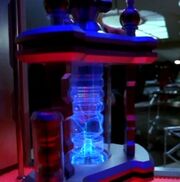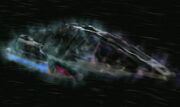m (cat change) |
Archer4real (talk | contribs) |
||
| (6 intermediate revisions by 3 users not shown) | |||
| Line 1: | Line 1: | ||
| − | [[File:Coaxial warp drive.jpg|thumb|A coaxial induction drive |
+ | [[File:Coaxial warp drive.jpg|thumb|A coaxial induction drive]] |
| + | [[File:Coaxial warp ship.jpg|thumb|The coaxial warp ship, emerging from coaxial warp]] |
||
| ⚫ | |||
| ⚫ | |||
| ⚫ | '''Coaxial warp drive''', also known as '''coaxial induction drive''' or simply '''coaxial drive''', was a [[propulsion system]] that functioned by drawing in [[subatomic particle]]s and reconfiguring their internal geometries. This allowed a [[starship]] the capability to fold the fabric of [[space]], allowing it to travel instantaneously across extremely large distances. ({{VOY|Vis à Vis}}) |
||
| ⚫ | |||
| − | Such a propulsion system was encountered in the [[Delta Quadrant]] by the crew of the {{USS|Voyager}} in [[2374]], when they came across [[Coaxial warp ship|a ship]] piloted by a [[Benthan]] named [[Steth]]. Emerging from coaxial space in an unstable condition, the vessel threatened to explode and collapse space within a radius of a billion kilometers. Such a catastrophe was averted, however, when [[Tom Paris]], ''Voyager''{{'}}s [[helmsman]], managed to generate a [[symmetric warp field]] around Steth's ship, containing the instabilities in the space-folding core. |
||
| + | ==History== |
||
| ⚫ | |||
| + | By the [[24th century]], the concept of coaxial warp drive had been hypothesized by [[Starfleet]] [[engineer]]s. |
||
| + | In [[2374]], an experimental [[coaxial warp ship]] was piloted by {{dis|Steth|impostor|a shapeshifter}} with the ability to switch its [[DNA]] with another individual, in essence switching bodies. The shapeshifter and its ship was encountered by the crew of the {{USS|Voyager}} in the [[Delta Quadrant]]. At the time, the shapeshifter was pretending to be a [[Benthan]] named [[Steth]] and claimed that the ship was also of Benthan origin. |
||
| ⚫ | |||
| ⚫ | The ''Voyager'' crew eventually discovered that |
||
| ⚫ | Emerging from coaxial space in an unstable condition, the vessel threatened to explode and collapse space within a radius of a billion kilometers. Such a catastrophe was averted, however, when [[Tom Paris]], ''Voyager''{{'}}s [[helmsman]], managed to generate a [[symmetric warp field]] around the coaxial warp ship, containing the instabilities in the space-folding core. The drive of the craft was imperfect, as particle instabilities tended to overload the engines. To correct for this flaw, Paris conceived of the idea of using a [[polaric modulator]] to dilute the particle stream as it entered the coaxial core, drawing inspiration from a [[20th century]] device known as a [[carburetor]]. |
||
| ⚫ | |||
| ⚫ | The ''Voyager'' crew eventually discovered that the impostor was not who he claimed to be when he switched places with [[Captain]] [[Kathryn Janeway|Janeway]], in an attempted to escape from ''Voyager'' using a [[Starfleet]] [[class 2 shuttle]] modified to use coaxial warp drive. Paris was able to prevent the escape by targeting the polaric modulator with a [[chromoelectric pulse]], disrupting the shuttles engines. ({{VOY|Vis à Vis}}) |
||
| ⚫ | |||
| + | |||
| ⚫ | |||
*[[Inverter]] |
*[[Inverter]] |
||
*[[Spatial trajector]] |
*[[Spatial trajector]] |
||
Revision as of 15:46, 14 December 2014

A coaxial induction drive
The coaxial warp ship, emerging from coaxial warp

A Starfleet shuttlecraft going to coaxial warp
Coaxial warp drive, also known as coaxial induction drive or simply coaxial drive, was a propulsion system that functioned by drawing in subatomic particles and reconfiguring their internal geometries. This allowed a starship the capability to fold the fabric of space, allowing it to travel instantaneously across extremely large distances. (VOY: "Vis à Vis")
History
By the 24th century, the concept of coaxial warp drive had been hypothesized by Starfleet engineers.
In 2374, an experimental coaxial warp ship was piloted by a shapeshifter with the ability to switch its DNA with another individual, in essence switching bodies. The shapeshifter and its ship was encountered by the crew of the USS Voyager in the Delta Quadrant. At the time, the shapeshifter was pretending to be a Benthan named Steth and claimed that the ship was also of Benthan origin.
Emerging from coaxial space in an unstable condition, the vessel threatened to explode and collapse space within a radius of a billion kilometers. Such a catastrophe was averted, however, when Tom Paris, Voyager's helmsman, managed to generate a symmetric warp field around the coaxial warp ship, containing the instabilities in the space-folding core. The drive of the craft was imperfect, as particle instabilities tended to overload the engines. To correct for this flaw, Paris conceived of the idea of using a polaric modulator to dilute the particle stream as it entered the coaxial core, drawing inspiration from a 20th century device known as a carburetor.
The Voyager crew eventually discovered that the impostor was not who he claimed to be when he switched places with Captain Janeway, in an attempted to escape from Voyager using a Starfleet class 2 shuttle modified to use coaxial warp drive. Paris was able to prevent the escape by targeting the polaric modulator with a chromoelectric pulse, disrupting the shuttles engines. (VOY: "Vis à Vis")
